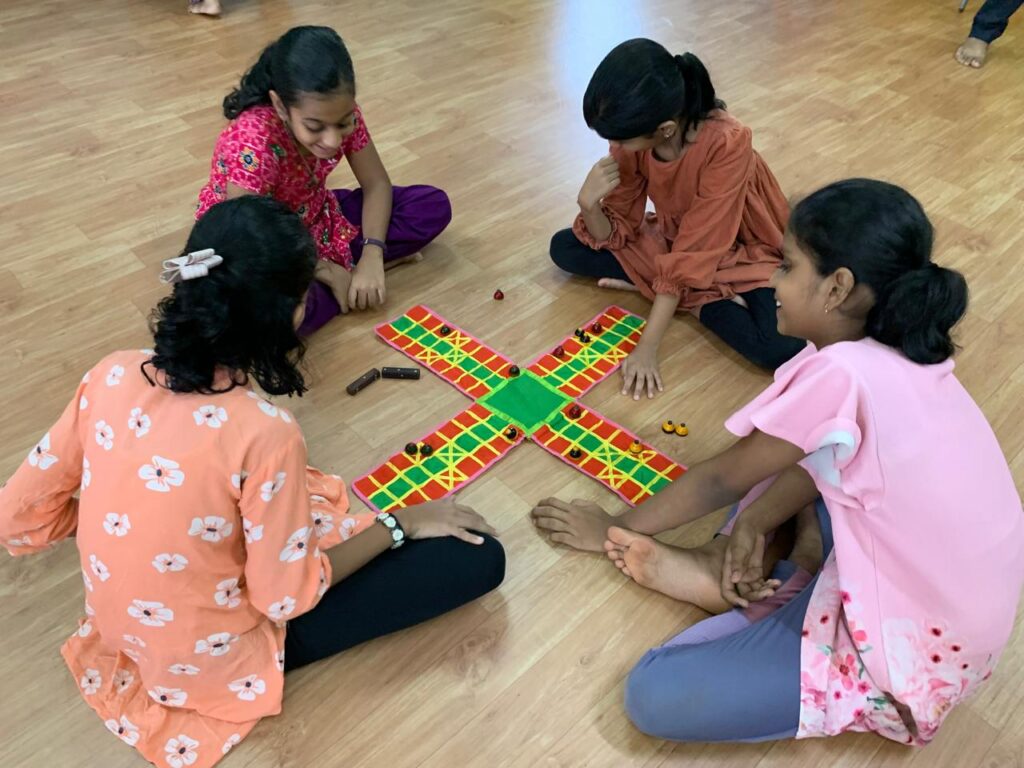Traditional Indoor Games

India’s traditional indoor games are an important part of our culture. In this blog, we are going to learn about are traditional indoor games of India and the benefits of playing the games.
Here are some entertaining traditional games for kindergarteners, adults and all ages.
1. Chaupar
- Overview:
Chaupar (also spelled as Chaupad or Chauparh) is one of India’s oldest and most famous traditional board games, with roots tracing back to ancient times. This game is believed to have been played by Indian royals and nobility, especially during the Mughal and Rajput eras. It encourages strategic thinking, patience, and social interaction. - Gameplay:
1) Rolling the Dice or Throwing Shells: Each player takes turns rolling dice or throwing shells to move their pieces.
2) Movement: Players move their pieces along the outer edge of the board in a counter clockwise direction.
3) Entering the Board: Players need to roll a specific number (usually a 5 or 6) to enter a piece from the starting area onto the board.
4) Capturing Opponents: If a player lands on a space occupied by an opponent’s piece, they ‘capture’ that piece, sending it back to the start. - Benefits:
1) Enhances critical thinking and foresight
2) The game teaches players to remain patient and focus on long-term strategies
3) Encourages communication, teamwork, and healthy competition
4) It Sharpens memory, concentration, and decision-making abilities.
2. Sisima
- Overview:
Sisima is an ancient board game that falls under the alignment games category, much like Tic Tac Toe or “X and O.” It has been played for centuries, offering both strategic depth and simplicity, making it accessible for players of all ages. Sisima is a two-player game where each player tries to outsmart the other by aligning their pieces in a straight row while simultaneously blocking the opponent’s moves. - Gameplay:
1) Players alternate turns to place their pieces on any empty point on the board.
2) Once all pieces are placed, players take turns moving their pieces to adjacent empty points.
3) Pieces can only move to adjacent points; jumping over other pieces is not allowed.
4) The goal is to align all three of your pieces in a straight row—either horizontally, vertically, or diagonally.
5) The game ends when a player successfully aligns their pieces or blocks their opponent from forming an alignment. - Benefits:
1) Enhances Strategic Thinking
2) Improves Problem-Solving Skills
3) Increases Focus and Concentration
4) Encourages Friendly Competition.
3. Adu Huli
- Overview:
Adu Huli, also known as Wagh Bakri or Bagh Bav, is an ancient two-player strategy board game widely played across India. This traditional game, often seen carved into caves, forts, and temples, represents a tactical battle between hunters (the tigers) and defenders (the sheep). Its appeal lies in the balance between offensive and defensive strategies, making it both engaging and intellectually stimulating. - Gameplay:
1) The Tigers must move from one intersection point to another without skipping any points. They aim to approach the Sheep strategically so that they can jump over and “eat” them.
2) The Sheep, entering the board one by one after each Tiger’s move, must avoid getting eaten and attempt to block the Tigers by positioning themselves on key points of the board.
3) If the Tiger manages to “eat” all the Sheep by jumping over them, the Tiger player wins.
4) If the Sheep successfully block all the Tigers, preventing them from moving further, the Sheep player wins. - Benefits:
1) Enhances Strategic Thinking
2) Improves Problem-Solving Skills
3) Increases Focus and Concentration
4) Encourages Cultural Connection.
4. Pacheta (5 stones game)
- Overview:
Pacheta, also known as 5 Stone Catching, is a traditional indoor game played using five small stones. The game involves tossing, catching, and picking up stones in a series of increasingly challenging steps. Players take turns performing specific actions, starting with throwing one stone into the air while quickly picking up other stones from the ground, without dropping the airborne stone. The aim of the game is to complete a series of increasingly difficult challenges involving five small stones, enhancing hand-eye coordination and dexterity. - Gameplay:
1) Toss all five stones on the ground. Pick one stone, throw it in the air, and quickly pick up one stone from the ground while catching the airborne stone with the same hand.
2) Repeat the same process, but this time, pick up two stones from the ground while catching the stone thrown in the air.
3) In this round, the player has to pick up three stones while catching the thrown stone.
4) Now, pick up four stones in a single movement while catching the airborne stone.
5) All five stones are placed together on the ground. The player must throw one stone in the air and, before catching it, pick up all four stones together. - Benefits:
1) Improves Hand-Eye Coordination
2) Enhances Focus and Concentration
3) Encourages Patience and Perseverance
4) Develops Fine Motor Skills
5) Promotes Social Interaction
